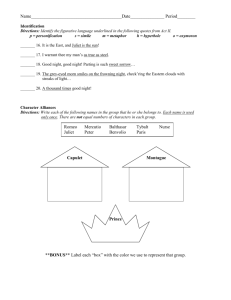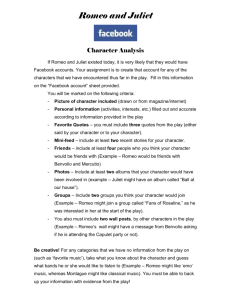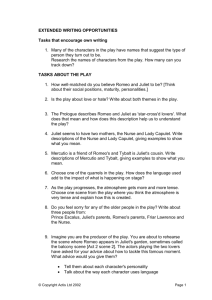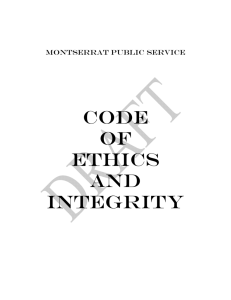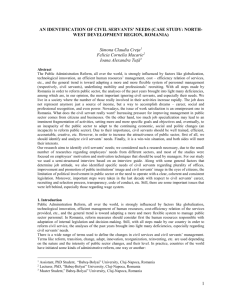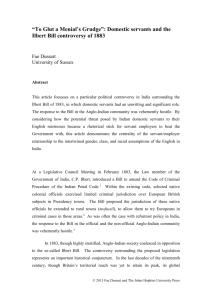ROMEO AND JULIET: DISCOVERY GUIDE
advertisement
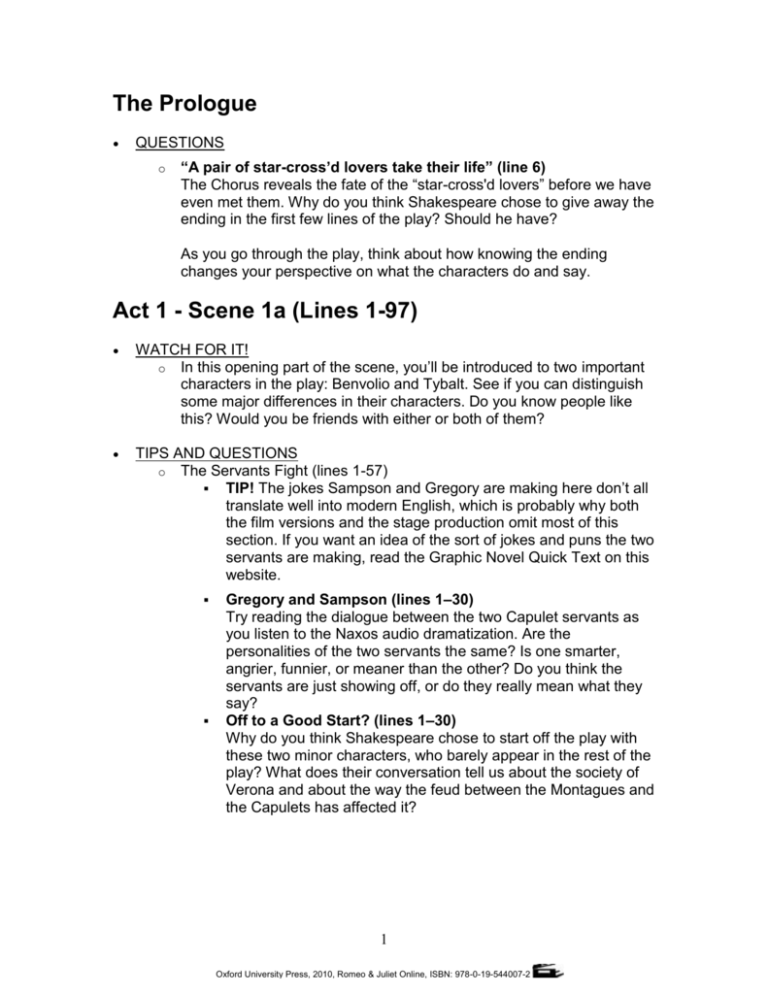
The Prologue QUESTIONS o “A pair of star-cross’d lovers take their life” (line 6) The Chorus reveals the fate of the “star-cross'd lovers” before we have even met them. Why do you think Shakespeare chose to give away the ending in the first few lines of the play? Should he have? As you go through the play, think about how knowing the ending changes your perspective on what the characters do and say. Act 1 - Scene 1a (Lines 1-97) WATCH FOR IT! o In this opening part of the scene, you’ll be introduced to two important characters in the play: Benvolio and Tybalt. See if you can distinguish some major differences in their characters. Do you know people like this? Would you be friends with either or both of them? TIPS AND QUESTIONS o The Servants Fight (lines 1-57) TIP! The jokes Sampson and Gregory are making here don’t all translate well into modern English, which is probably why both the film versions and the stage production omit most of this section. If you want an idea of the sort of jokes and puns the two servants are making, read the Graphic Novel Quick Text on this website. Gregory and Sampson (lines 1–30) Try reading the dialogue between the two Capulet servants as you listen to the Naxos audio dramatization. Are the personalities of the two servants the same? Is one smarter, angrier, funnier, or meaner than the other? Do you think the servants are just showing off, or do they really mean what they say? Off to a Good Start? (lines 1–30) Why do you think Shakespeare chose to start off the play with these two minor characters, who barely appear in the rest of the play? What does their conversation tell us about the society of Verona and about the way the feud between the Montagues and the Capulets has affected it? 1 Oxford University Press, 2010, Romeo & Juliet Online, ISBN: 978-0-19-544007-2 o The Fight Escalates (lines 58-97) Tybalt and Benvolio (lines 58–66) What are your impressions of these two men? Try saying the two names out loud. What feeling do you get from each one? Click on their names in the Playscript to read the “What’s in a Name?” feature in the character description. Now read, watch, or listen to the part where they meet. Does each character live up to his name in this brief interchange? Who’s Accountable? (lines 67–74) Servants start the fight, but in a short time the brawl draws in people from higher levels of society. For people in Shakespeare’s day, rank and status were important, and the idea that noblemen such as Lord Capulet and Lord Montague would join a fight started by their underlings was a dangerous reversal of the social order. Who do you think is most accountable here? The servants who started the fight? Tybalt and Benvolio for not putting an end to it? Or Capulet and Montague for allowing it to escalate? Why? The Prince’s Speech (lines 75–97) The Prince comes onto the scene and restores order. Listen to either the Naxos or Arkangel audio dramatization of the speech, and follow along in the text. As you read and listen, notice how different the Prince's way of speaking is from that of the servants at the beginning of the play (and even from Tybalt’s and Benvolio’s way of speaking.) How would you describe these differences? How do you think the Prince is feeling while he is saying these words? Is he angry? Resigned? Frustrated? Calm? Why? MEDIA SPOTLIGHT o Innocent Bystanders Take a look at the stills from the Stratford Festival 2008 production. Notice that a young woman with a baby carriage becomes involved in the brawl. Why do you think the director chose to include her here? What could she represent or symbolize? In other words, who or what is caught in the middle of this terrible fight? Now watch the CBC/Stratford Festival, Luhrmann, and Zeffirelli film versions. What details do you notice in each one that emphasize the 2 Oxford University Press, 2010, Romeo & Juliet Online, ISBN: 978-0-19-544007-2 effect of the violence on Verona’s citizens? How might these innocent bystanders influence the audience’s reaction to the violence? 3 Oxford University Press, 2010, Romeo & Juliet Online, ISBN: 978-0-19-544007-2
